About the Site

The Schiermeier Olentangy River Wetlands Research Park is an area located just north of OSU campus. The 52-acre urban research site is situated adjacent to the Olentangy River and consists of two experimental wetland basins, an oxbow wetland, bottomland hardwood forest, and a mesocosm compound. It also doubles as a great, albeit short, hiking destination complete with a multitude of interesting flora to observe! The park consists of a large pond in its center, with various data-collection instruments strewn about inside. Surrounding the pond are a multitude of winding trails that weave their way around the center. Some of these trials are for the public, while some of these are meant for the researching staff. It was quite hard to identify which was which at times, but I had fun exploring even with all abundant poison ivy.
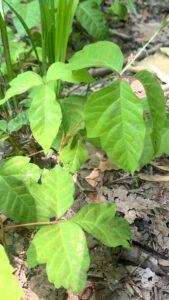
Poison Ivy (Toxicodendron pubescens)
To properly identify poison ivy, look for the distinctive 3 leaflets with a longer middle leaf. Also pay attention to the edges of the leaves, as poison ivy leaves are generally serrated.
Flowers and Inflorescences

Foxglove Beardtongue (Penstemon digitalis)
- Description of Flower: The flowers of Penstemon digitalis have bilateral symmetry. The parts of the flower are fused to form a tubular shape with five petals that are typically white or pale pink. It has five stamens and a single pistil. The flower exhibits hypogynous insertion, where the sepals, petals, and stamens are attached at the base of the ovary.
- Habitat: Penstemon digitalis is native to North America and can be found in prairies, meadows, open woods, and roadsides.
- Inflorescence Type: Penstemon digitalis typically has a raceme inflorescence, with flowers arranged along a central stalk.
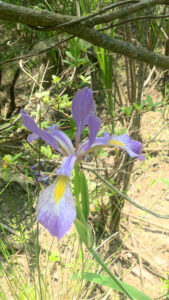
Southern Blue Flag (Iris virginica)
- Description of Flower: The flowers of Iris virginica have bilateral symmetry. They consist of three sepals and three petals that are often blue or purple, with a distinctive large petal (called the “standards”) that is erect or spreading, and three smaller, downward-curving petals (called the “falls”). The stamens and style are fused into a column-like structure. The flower exhibits perigynous insertion, where the sepals, petals, and stamens are attached to the floral cup that surrounds the ovary.
- Habitat: Iris virginica is native to eastern North America and is commonly found in wetlands, along stream banks, and in marshy areas.
- Inflorescence Type: Iris virginica typically has a solitary flower, but multiple flowers can also be found on a stem.
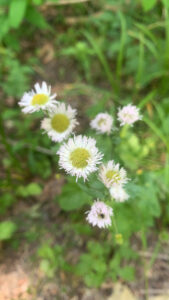
Philadelphia fleabane (Erigeron philadelphicus)
- Description of Flower: The flowers of Erigeron philadelphicus have radial symmetry. They consist of numerous small, daisy-like florets that are typically white or pale pink, with a yellow center. Each floret has a five-lobed fused corolla. The flower exhibits a syncarpous gynoecium, where the carpels are fused together to form a single pistil.
- Habitat: Erigeron philadelphicus is native to North America and can be found in fields, meadows, and open woodlands.
- Inflorescence Type: Erigeron philadelphicus typically has a corymb or panicle inflorescence, where the flowers are arranged in clusters at the ends of branches.
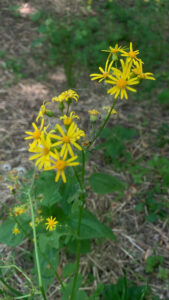
Golden Ragwort (Packera aurea)
- Description of Flower: The flowers of Packera aurea have radial symmetry. They consist of numerous small, yellow disc florets that are grouped in clusters, surrounded by several yellow ray florets. Each floret has a five-lobed fused corolla. The flower exhibits a syncarpous gynoecium, where the carpels are fused together to form a single pistil.
- Habitat: Packera aurea is native to North America and can be found in wet meadows, stream banks, and woodland areas.
- Inflorescence Type: Packera aurea typically has a corymb or panicle inflorescence, where the flowers are arranged in clusters at the ends of branches.
Invasive Plants
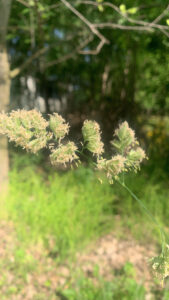
Orchard grass (Dactylis glomerata)
- Origin: Dactylis glomerata, commonly known as Cock’s-foot or Orchard Grass, is native to Europe, Asia, and North Africa.
- Ecosystem Impact: Dactylis glomerata can become invasive in grasslands, meadows, pastures, and disturbed areas. It can outcompete native grasses and forbs, reducing biodiversity and altering ecosystem dynamics.
- Control Measures: Control measures for Dactylis glomerata include regular mowing or cutting before seed set to prevent further spread. Herbicides can be used selectively, but care must be taken to avoid damaging desirable vegetation. Promoting the growth of native grasses and forbs through proper land management practices can also help suppress its spread.
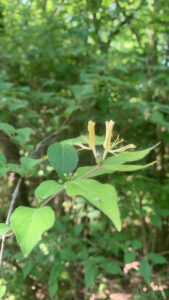
Amur Honeysuckle (Lonicera maackii)
- Origin: Lonicera maackii, commonly known as Amur honeysuckle, is native to eastern Asia, including China, Japan, and Korea.
- Ecosystem Impact: Lonicera maackii is a highly invasive shrub that forms dense thickets in a variety of habitats, including forests, woodlands, and riparian areas. It outcompetes native plants, reduces native biodiversity, and alters nutrient cycling.
- Control Measures: Control measures for Lonicera maackii include mechanical removal by cutting or pulling small plants, especially before seed production. For larger infestations, herbicides can be used, but care must be taken to follow label instructions and avoid harming non-target species. Restoration efforts should focus on replanting native species and preventing further spread through monitoring and early detection.
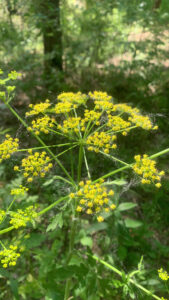
Wild Parsnip (Pastinaca sativa)
- Origin: Pastinaca sativa, commonly known as Wild Parsnip, is native to Europe and Asia.
- Ecosystem Impact: Pastinaca sativa is an invasive plant that can be problematic in grasslands, meadows, roadsides, and disturbed areas. It forms dense stands, outcompeting native vegetation and reducing biodiversity. It also produces sap that can cause skin irritation and burns when exposed to sunlight.
- Control Measures: Control measures for Pastinaca sativa include mechanical removal by digging out the plants, ensuring the removal of the entire taproot. It is important to wear protective clothing to prevent skin contact with the sap. Herbicides can be used selectively, but care must be taken to minimize damage to non-target species. Control efforts should focus on early detection and eradication to prevent seed production and further spread.
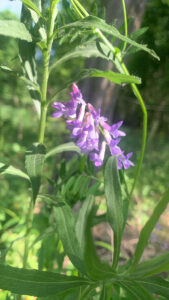
Tufted Vetch (Vicia cracca)
- Origin: Vicia cracca, commonly known as Tufted Vetch, is native to Europe, Asia, and North America.
- Ecosystem Impact: Vicia cracca is considered invasive in some regions, particularly in grasslands, meadows, and disturbed areas. It can smother and outcompete native vegetation, reducing plant diversity and forage availability for livestock.
- Control Measures: Control measures for Vicia cracca include manual removal by cutting or pulling, especially before seed production. Herbicides can be used selectively, targeting the vetch while sparing desirable species. Promoting healthy stands of desirable vegetation through proper land management practices can help suppress its growth and spread.
Plant Fruits!
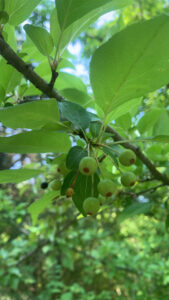
Pacific Crab Apple (Malus fusca)
- Fruit Type: The fruit of Malus fusca, commonly known as Pacific Crabapple, is a pome.
- Description: A pome is a type of fruit that develops from the ovary of a flower, where the fleshy part of the fruit comes from the floral tube. In the case of Malus fusca, the fruit is small and round, typically ranging from green to yellow or reddish in color. It has a firm flesh with a core containing seeds. Pomes are characteristic of the Rosaceae family, which includes apples and related species.
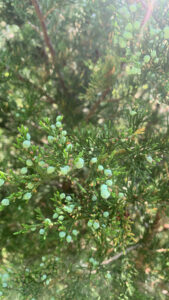
Eastern Redcedar (Juniperus virginiana)
- Fruit Type: The fruit of Juniperus virginiana, commonly known as Eastern Red Cedar or Virginia Juniper, is a cone.
- Description: Cones are the reproductive structures of gymnosperms, which include conifers like Juniperus virginiana. The cones of Juniperus virginiana are small and round, ranging in color from green to bluish-purple. They are composed of overlapping scales, and each scale contains one to three seeds. The cones are woody and can persist on the tree for multiple years before releasing their seeds.

Mock Strawberry (Potentilla indica)
- Fruit Type: The fruit of Potentilla indica, commonly known as Indian Strawberry or Mock Strawberry, is an aggregate accessory fruit.
- Description: An aggregate accessory fruit is a type of fruit that develops from multiple ovaries of a single flower. In the case of Potentilla indica, the fruit resembles a small strawberry but is dry and does not have the same sweet taste as true strawberries. It consists of numerous tiny, dry, seed-like structures (achenes) attached to the surface of a fleshy receptacle. The achenes are the true fruits, while the fleshy receptacle is not directly involved in seed production.
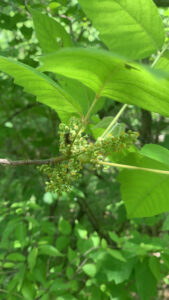
Sawtooth Blackberry (Rubus argutus)
- Fruit Type: The fruit of Rubus argutus, commonly known as Sawtooth Blackberry or Highbush Blackberry, is an aggregate fruit.
- Description: An aggregate fruit is similar to an aggregate accessory fruit, developing from multiple ovaries of a single flower. The fruit of Rubus argutus is composed of numerous small drupelets, each containing a seed. These drupelets are attached to a fleshy receptacle, forming a cluster of berries. The drupelets are the true fruits, and the fleshy receptacle contributes to the overall structure of the fruit.
Lichens
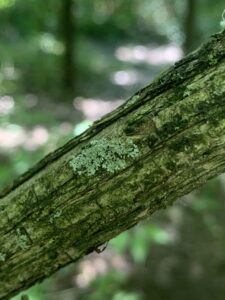
Star-Rosette Lichen (Physcia stellaris)
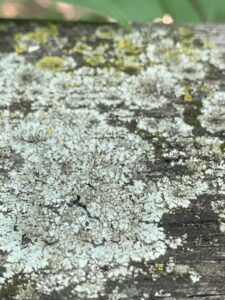
Powder-Edged Ruffle Lichen (Parmotrema hypotropum)

Candleflame Lichen (Candelaria concolor)
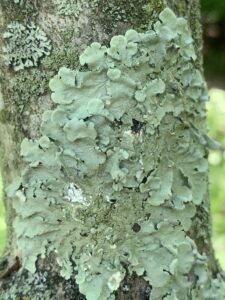
Common Greenshield Lichen (Flavoparmelia caperata)
